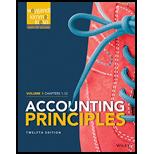
(a)
Liabilities: The liabilities are referred as a company’s financial obligation; arise during the course of the business cycle, which will be settled by the outflow of resources. Whenever any transaction raises the amount of liability, the liability account will be credited.
To explain: The long-term liabilities and its three examples.
(a)
Explanation of Solution
Long-term liabilities are the liabilities of the company which can be converted into cash after the duration of twelve months. Long-term liabilities define the long-term perspective or goals of the company.
Examples of the long-term liabilities are as follows:
- Bonds payable.
- Loan payable.
Deferred tax liabilities .
Notes:
Bonds payable: Bond is a debt instrument of the company which issued at the time when the company requires more fund. Bonds payable is the long-term liability of the company because the repayment of the bonds cannot be made within the period of 12 months.
Loan payable: The company can borrow the money from the bank in the form of a business loan or another. These all kind of loans shows the long-term liabilities of the company.
Deferred tax liability: Deferred tax liability shows the provision made by the company for the payment of tax.
Long-term liabilities refer the liabilities which can be paid off after the duration of twelve months. Bonds payable, loans payable and
(b)
To explain: The bonds.
(b)
Answer to Problem 1Q
Solution:
Bond is a debt instrument of the company which issued at the time when the company requires more funds.
Explanation of Solution
- The company has various sources of finance such as a loan from a bank, issuance of bonds or debentures.
- There are the various types of bonds such as secured and unsecured bonds, term and serial bond, registered and bearer bonds and convertible and callable bonds.
Bond is a type of debt which is issued by the company which facilitates the requirement of funds in the company.
Want to see more full solutions like this?
Chapter 15 Solutions
Accounting Principles, Volume 1: Chapters 1 - 12
- Melford Industries sells a product to a wholesaler for $52. The wholesaler applies a 30% markup based on selling price when selling to a retailer. The retailer then applies a 40% markup based on selling price to determine the final price to the consumer. What is the final selling price to the consumer? Answerarrow_forwardI need help with this general accounting problem using proper accounting guidelines.arrow_forwardIf sales revenue is $220 million and accounts receivable decreased by $30 million, the amount of cash received from customers: a. was $150 million. b. was $125 million. c. depends on the mix of cash sales and credit sales. d. was $250 million.arrow_forward
- Please provide the solution to this financial accounting question with accurate financial calculations.arrow_forwardPlease explain this financial accounting problem by applying valid financial principles.arrow_forwardHenry is an all-equity firm that has 63,500 shares of stock outstanding at a market price of $22.80 per share. The firm is considering a capital structure with 45% debt at a rate of 6% and use the proceeds to repurchase shares. Determine the shares outstanding once the debt is issued.arrow_forward

 AccountingAccountingISBN:9781337272094Author:WARREN, Carl S., Reeve, James M., Duchac, Jonathan E.Publisher:Cengage Learning,
AccountingAccountingISBN:9781337272094Author:WARREN, Carl S., Reeve, James M., Duchac, Jonathan E.Publisher:Cengage Learning, Accounting Information SystemsAccountingISBN:9781337619202Author:Hall, James A.Publisher:Cengage Learning,
Accounting Information SystemsAccountingISBN:9781337619202Author:Hall, James A.Publisher:Cengage Learning, Horngren's Cost Accounting: A Managerial Emphasis...AccountingISBN:9780134475585Author:Srikant M. Datar, Madhav V. RajanPublisher:PEARSON
Horngren's Cost Accounting: A Managerial Emphasis...AccountingISBN:9780134475585Author:Srikant M. Datar, Madhav V. RajanPublisher:PEARSON Intermediate AccountingAccountingISBN:9781259722660Author:J. David Spiceland, Mark W. Nelson, Wayne M ThomasPublisher:McGraw-Hill Education
Intermediate AccountingAccountingISBN:9781259722660Author:J. David Spiceland, Mark W. Nelson, Wayne M ThomasPublisher:McGraw-Hill Education Financial and Managerial AccountingAccountingISBN:9781259726705Author:John J Wild, Ken W. Shaw, Barbara Chiappetta Fundamental Accounting PrinciplesPublisher:McGraw-Hill Education
Financial and Managerial AccountingAccountingISBN:9781259726705Author:John J Wild, Ken W. Shaw, Barbara Chiappetta Fundamental Accounting PrinciplesPublisher:McGraw-Hill Education





